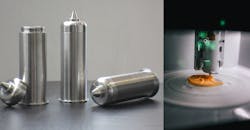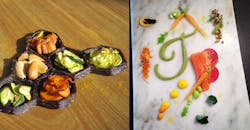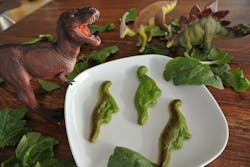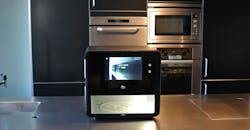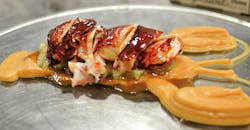3D Food Printers: The Next Must-Have Kitchen Appliance
We're getting fatter, folks. Obesity, which is a Body Mass Index of 30, has steadily climbed in every state since the early '90s, with half counting at least 30% of their adult population as obese. Manufacturing technology got us into this mess by figuring out how to cheaply and efficiently mass produce Pop Tarts, Lunchables and frozen dinners for our grab-and-go society. And now, one 3D printer company thinks that same technology could help get us out of our unhealthy obsession with processed foods.
Natural Machines, headquartered in Barcelona, makes the Foodini, a 3D printer that uses five stainless steel capsules to extrude liquid and viscous food, made from real, fresh ingredients, instead of melted plastic, onto a plate or other food. If it's a pizza or something else that needs to be cooked, then you place it in the oven.
It's being used by Michelin starred chefs and other culinary professionals now and could be in consumer kitchens around the world by the time humanity is expected to reach Mars in the early 2030s.
"We believe that in the next 10 to 15 years, 3D food printers will become a common a kitchen appliance, like a microwave or oven," says Lynette Kucsma, the company's co-founder and CMO.
Because it has variable speeds, pressures and nozzle sizes, Foodini allows for several types of food, such as tomato sauce and dough, to be printed quickly.
"No one is going to wait hours to print dinner," Kucsma notes.
You just push a button on the touchscreen or connected smart device and recipes and instructions appear to walk you through the process, like a very high-tech cook book. Then it starts printing.
But don't expect this Internet of Things-connected appliance, slated to go into mass production in 2017, to replace cooking all together.
"People have the Star Trek replicator in their heads a lot when they think about 3D printing," she says. "We're quite far away from that."
Instead of science fiction fantasy, this enterprise is merely scaling down traditional methods.
"If you eat anything from a food manufacturer or prepackaged food from a supermarket, you're already eating 3D-printed food," Kucsma explains. "What a food manufacturer does with food is push it through machines and shape and form it. We're taking that concept and we've shrunk it down to a design consumer appliance that sits on your kitchen counter. The big difference is we ship with empty food capsules, so you print using your own fresh, natural ingredients."
For the chefs using the $1,300 Foodini right now, it allows them to create amazing patterns and plate presentation in an automated way, allowing for delicious works of art like these:
That may seem like a fairly niche use, but experiments have shown that the way food looks does affect the perception of taste.
And Kucsma, who tried it out at home, has seen similar results with the group even more hard to impress than fancy gourmands and fine dining snobs: children.
"I made a spinach quiche, and my kids didn’t want it; they said they didn’t like it," she recalls. "But I took the same recipe and shaped them into dinosaurs influenced form the ones in their bedroom and they ate every single one. For me personally, with two younger kids, anything that gets them to eat healthier is a win in my book."
Because there are no tubes, clean up is pretty simple: just sponge it down. The capsules are dishwasher safe and with no tubes, no microbes can fester in little crevices.
Before for Foodini to become the next microwave, Natural Machines knows it has to add one major element: The capability to cook.
Currently, the machine can heat the capsules to keep chocolate at a good melting point or ensure mashed potatoes stay warm.
A future version could take raw meat or fish, cook them, and print ready-to-eat dishes.
"We're actually developing that machine," Kucsma says." The technology is real."
Kucsma says when the idea was being pitched, there was pressure to use the Keurig model, with prepackaged capsules that squirt out some artificial concoction. Think liquid Lunchables.
"That goes against our whole ethos, and why we started the company in the first place," Kucsma says. "It's not just about making money. It's about having people eat healthier."
Natural Machines does see a business model where grocery stores can sell prepare and sell capsules packed with fresh ingredients, as well as working with food manufacturers to make capsules with little to no artificial preservatives.
The startup began in 2012, when consumer 3D printing was as hyped up as Dorsia on Friday night. If something in your home breaks, just press a button and a repair part is instantly manufactured. Only your imagination could limit what these magic boxes could create. That excitement eventually caused Stratasys and 3D Systems' stocks to surge by 333% and 800% respectively. Then people realized the technology wasn't developing at the same speed as the geek gadget media and sci-fi movies told them it should. By 2015, many manufacturers were worth a quarter of what they were at peak value.
Kucsma isn't worried about a food-printing bubble, though.
"We eat every day, she says. "That’s something people do need. From that standpoint we were very confident."
But really, when can we get one?
Kucsma isn't refuses to answer, because she's learned from that guy who said we'd get to Mars in the early 2030s.
"Elon Musk is always late on deadline and gets killed by press," she says. "That's one reason why I will not tell you why our cooking device is coming out. Because I don't know yet."
And while she compares the Foodini to the microwave, this appliance could restore the balance to our diets that microwaves threw off by allowing us to be so impatient and lazy. It won't be as easy as puncturing cellophane and zapping a cardboard box for three minutes, but the nutritional value will be worth it.
"It's not fastest way to get food," Kucsma acknowledges. "But our goal is to get people back into kitchens and start cooking with fresh real ingredients, which is a macro trend anyway. This is a tool in people's kitchens to get them to do that."
About the Author
John Hitch
Editor, Fleet Maintenance
John Hitch, based out of Cleveland, Ohio, is the editor of Fleet Maintenance, a B2B magazine that addresses the service needs for all commercial vehicle makes and models (Classes 1-8), ranging from shop management strategies to the latest tools to enhance uptime.
He previously wrote about equipment and fleet operations and management for FleetOwner, and prior to that, manufacturing and advanced technology for IndustryWeek and New Equipment Digest. He is an award-winning journalist and former sonar technician aboard a nuclear-powered submarine where he served honorably aboard the fast-attack submarine USS Oklahoma City (SSN-723).

